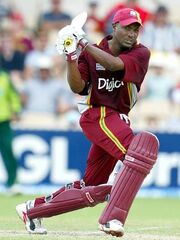
Aged 14, Lara made 745 runs at 126.16, earning him selection for the Trinidad Under-16 team. A year later he was in the West Indies Under-19 side. In 1990, aged 20, Lara became Trinidad and Tobago's youngest captain, leading them to victory in the Geddes Grant Shield. In that year he made his Test debut, scoring 44 and 6 against Pakistan.
No-one since Bradman has built massive scores as often and as fast as Lara in his pomp. Even his stance was thrilling - the bat raised high in the air, the weight poised on a bent front knee, the eyes low and level. Then the guillotine would fall, sending the ball flashing to the boundary. In the space of two months in 1994, Lara's 375 and 501 not out broke world records for the highest Test and first-class scores, but sudden fame turned him into a confused and contradictory figure. During an inventive but largely fruitless spell as captain of a fading team, Lara reiterated his genius by single-handedly defying the 1998-99 Australian tourists with a sequence of 213, 8, 153 not out and 100. For a while, excess weight and hamstring problems hampered his once-lightning footwork, and the torrent of runs became an occasional spurt. But after Garry Sobers suggested a tweak to his flourishing backlift, Lara returned to his best in Sri Lanka in 2001-02, with 221 and 130 in one Test and 688 runs - a record 42% of West Indies' output - in the series, and reclaimed the captaincy the following year.
The task proved as hard second time round, leading a side where he was far and away the best player and where discipline was a constant worry. He led them to defeat for a second time in South Africa, and then lost to England in the Caribbean, too. But then, just when all hope seemed to have deserted West Indies cricket, Lara responded to the prospect of a home series whitewash with an astonishing unbeaten 400 in the final Test against England in Antigua. In doing so, he became the first man to reclaim the world Test batting record, a feat that ensured he would stand alongside Shane Warne as the most charismatic cricketer of the modern era.
Then followed a spectacular low, when Bangladesh came visiting and had West Indies in trouble in the one-day series and the first Test, prompting Lara to threaten his resignation if his batsmen did not lift their game. They responded in the following game, and Lara captained the side in England, where the team was beaten in every Test they played. Astonishingly, he then galvanised his charges and led the one-day team to victory in the ICC Champions Trophy to spark off hopes of a West Indies resurgence. But it was under Shivnarine Chanderpaul that Lara registered his next big moment - in Adelaide in November 2005, when he went past Allan Border's tally of 11174 runs to become Test cricket's most prolific scorer. Then in April 2006, after protracted dispute between the West Indies board and the players union (WIPA), he was reinstated - for the third time - as West Indies captain. Lara's leadership in the five-match one-day home series against India came in for much praise as the tourists were knocked over 4-1, but in the succeeding Test series he struggled. His captaincy was erratic - inspiring in parts, questionable on many occasions - though he later revealed that his hands were tied due to peripheral issues related to team selection.
In Pakistan he led by example with the bat but results continued to go against his side and as West Indies struggled both on and off the field, it became increasingly obvious that Lara was unable to inspire them to greater things, and he appeared increasingly at odds with many of his team-mates. The World Cup offered him a chance to bow out on home soil and on a high, but it was not to be. He showed glimpses of his abilities, but one fifty in seven innings was not enough as West Indies went out with a whimper. He quit, one ODI short of his 300, amid rumours of bitter disputes with administrators.